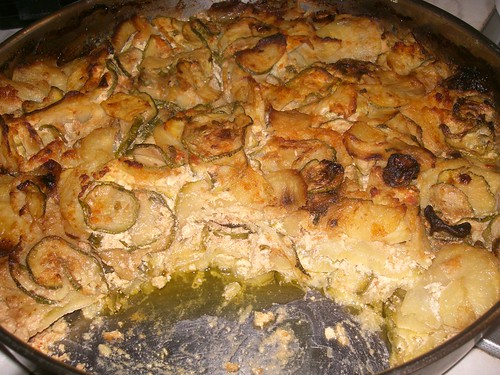Sometimes I wonder whether the neighbouring village is actually another country when I hear of the many different variations for making a particular Cretan dish. Let's take the well-known boureki:
"Didn't you top your boureki with some pastry?"
"You didn't grate any tomato over the mizithra in the boureki?"
"You forgot to add garlic to the boureki!"
Why is it that Greeks cannot agree on how a dish is cooked? How did regional variations of the same meal come about?
 My mother, who came from Kambi, never used tomato or garlic in her boureki. She topped it with home-made pastry, making it look more like a pie with a self-crusting bottom. Don't be surprised if the locals in Nerokouro also make their boureki like this; as people moved away from the mountains, preferring lower flatter land close to the main town (Hania), they often moved to a village in their proximity on lower ground, taking their culinary practices with them. Many members from my mother's family live in Nerokourou.
My mother, who came from Kambi, never used tomato or garlic in her boureki. She topped it with home-made pastry, making it look more like a pie with a self-crusting bottom. Don't be surprised if the locals in Nerokouro also make their boureki like this; as people moved away from the mountains, preferring lower flatter land close to the main town (Hania), they often moved to a village in their proximity on lower ground, taking their culinary practices with them. Many members from my mother's family live in Nerokourou.
My mother-in law comes from Fournes; she uses garlic and tomato in her boureki, as does Dimitra's sister-in-law, who comes from Lakki. These villages get their water from the same source: Lakki is the next village one comes across after Fournes, before reaching the Omalos plateau where the Samaria Gorge begins, an 18-kilometre stretch ending on the northern coastline of Hania.
Both Kambi and Lakki are villages at the foot of Lefka Ori, the mountain range at the centre of Hania. They have only recently become accessible to one another (without having to drive away from the mountain to find the road that drives into their route) by a road which crosses through Therisso, another village on the foothills of Lefka Ori. This road was once a footway used by shepherd and their flocks, widened by the passage of time, and eventually by bulldozers, making Crete more accessible than it ever has been.
The regional differences in cooking styles were known to people before the depopulation of villages and migration to urban centres became commonplace, through the marriages of people from different villages. Wikipedia mentions the pastry boureki without tomato, which is the one more commonly found in cookbooks (such as the famous Psilakis cookbook on Cretan cookery). Another website describes the tomato-without-pastry version. Interestingly enough, the same website mentions another recipe (for marathopites - fennel pies) which is specific to the areas where the tomato boureki version is more common, which would make me think that the recipe writer is connected in some way with the area. The way someone cooks a meal often signals their origins.
But where does the word 'boureki' come from? It is used right throughout the countries formerly connected to the Ottoman Empire, Greece being one of them. In each country and different region, boureki (or burek, or boreg, among quite a few variants) refers to some kind of pie, usually made with cheese and pastry. The word is clearly Turkish in origin.

Whichever way you prefer to make your boureki, it's delicious.
©All Rights Reserved/Organically cooked. No part of this blog may be reproduced and/or copied by any means without prior consent from Maria Verivaki.
Great, thought-provoking post. A recipe may start out the same everywhere. Then one person gets creative and adds a new ingredient, or new flavor, or new technique. Their friends and relatives like it so start making the variation. This process happens over and over again as new dishes develop and come into being and some old ones fade away and other old ones keep going in their original form. This exact, natural, evolutionary process is why I disagree with those who object to people taking liberties with traditional recipes or insist that something must be made the same way every time.
ReplyDeleteI intend to try it with straight neck yellow squash, as that is what I am growing this year. I have a few potato hills, but they won't be ready when the first squash, are so they will come from the farmers market. Our winter is hanging on so long in the Rocky Mts. this year, it may be a late summer dish. We are still having cold foggy rains with snow at higher elevations.
ReplyDeleteWhat makes bouureki self crusting? You didn't mention anything about flour.
hi momcat
ReplyDeletewhen boureki cools slightly, it can be cut and served like a pie - it isnt as stable as a pie, but i think what keeps it together is the curd cheese and potato juices...
some people do add flour to it, but i never do - i cant imagine purposely increasing the flour content in this dish just to make it more stable
Thanks so much for this info, great recipes, and variations! Brings back so many warm memories, savory smells, and spicy delights of my time near Hania, Crete. Loved it there!
ReplyDelete